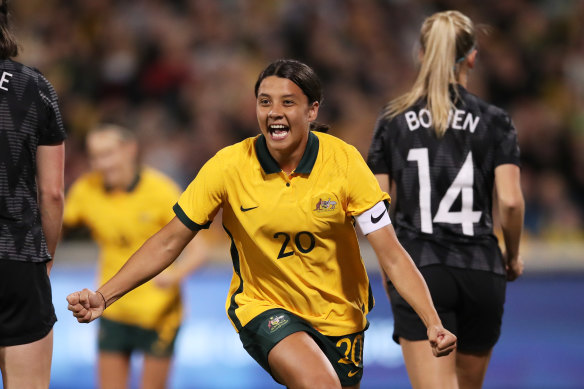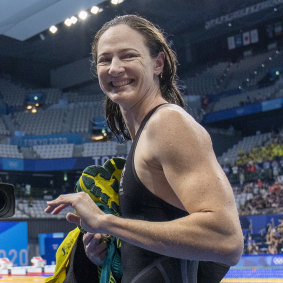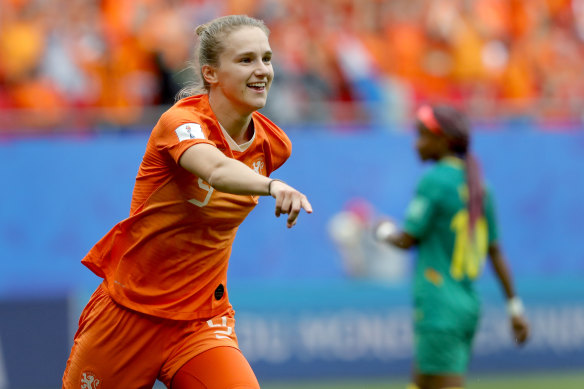Everything you need to know about the FIFA Women’s World Cup draw
It’s feeling increasingly real. In less than nine months, the first senior FIFA World Cup held in this country, for men or women, will begin.
On Saturday night, we’ll find out who will play where, which teams will be in Australia’s group, and what the two possible paths in the knockout stage could look like for the Matildas when the official draw is conducted in Auckland.
Sam Kerr and the Matildas will find out who’s in their group for the Women’s World Cup on Saturday.Credit:Getty
All sorts of football dignitaries, including FIFA president Gianni Infantino and his second-in-command Fatma Samoura, will be on hand in New Zealand’s most populous city to observe a time-honoured football tradition: the selection by various celebrities of random balls from glass fishbowls, containing pieces of paper inscribed with the name of a country, which said celebrities then show off to television cameras like a proud parent.
Seriously, though, it’s exciting.
Hold up, hold up – first of all, why is it in Auckland?
A great question – and a good time to remind all Australians that we are actually co-hosting the Women’s World Cup with New Zealand. It hasn’t always felt that way on this side of the Tasman, where we often claim their successes as entirely our own, but it’s true. The Kiwis get the pomp and ceremony of the draw, the play-in tournament (I’ll explain in a sec), and the opening match at Eden Park on July 20 – we get the final, which will be played at Sydney’s Accor Stadium on August 20, as well as the third-place play-off in Brisbane the day before.
Groups A, C, E and G will be held entirely within New Zealand, and groups B (which the Matildas are in), D, F and H are in Australia– so if you want to see a particular team play here, you’ll need to pray for them to land in one of those.
So how does it actually work?
There are four pots of eight teams each. The world’s top six nations according to FIFA, along with co-hosts Australia and New Zealand, are in pot one – and from there, they’re all in descending order, except for the last three spots in the final pot, which will go to the winners of the aforementioned play-offs in February.
The Matildas have already been pre-selected in Group B, and the same with the Football Ferns in Group A. The rest of the teams will be drawn from the four pots.
With the exception of UEFA, teams from the same confederation can’t be drawn in the same group. For example, the Matildas (who are in the AFC) can’t draw China, Japan or South Korea (pot two) or Vietnam (pot three). In pot four, however, are vacancies for three to-be-determined teams.
POTS FOR THE WOMEN’S WORLD CUP DRAW
Pot one: New Zealand (FIFA ranking 22), Australia (13), United States (1), Sweden (2), Germany (3), England (4), France (5), Spain (6)
Pot two: Canada (7), Netherlands (8), Brazil (9), Japan (11), Norway (12), Italy (14), China (15), South Korea (17)
Pot three: Denmark (18), Switzerland (21), Republic of Ireland (24), Colombia (27), Argentina (29), Vietnam (34), Costa Rica (37), Jamaica (43)
Pot four: Nigeria (45), Philippines (53), South Africa (54), Morocco (76), Zambia (81), play-off Group A winners (Cameroon, Thailand or Portugal), play-off Group B winners (Senegal, Haiti or Chile), play-off Group C winners (Chinese Taipei, Paraguay, Papua New Guinea or Panama)
In February, a novel play-in tournament will be held in New Zealand in which 10 teams fight for those final three berths. Since we don’t know who that will be, for the purposes of the draw, FIFA will treat the placeholder slots as if they are a European, South American and Asian/Oceanian team respectively.
Make sense?
Aussie swimming great Cate Campbell will be one of the ‘draw assistants’.Credit:Getty
Crystal clear. Who is going to be conducting the draw?
FIFA has called it a “star-studded line-up”: Matildas legend Julie Dolan and ex-Football Fern Maia Jackman will be joined by former England and Arsenal striker Ian Wright, 96-time American international and pundit Alexi Lalas, 2002 Men’s World Cup winner Gilberto Silva of Brazil and Cameroonian great Geremi as the draw “assistants” – along with two former Olympic gold medallists, New Zealand snowboarder Zoi Sadowski-Synnott and Aussie swimmer Cate Campbell.
Two-time Women’s World Cup champion Carli Lloyd and CNN anchor Amanda Davies are the “conductors”.
There’ll be about 800 guests at the Aotea Centre in Auckland, including New Zealand Prime Minister Jacinda Ardern, Australian Sports Minister Anika Wells, a bunch of FIFA “legends”, Infantino, Samoura, and representatives from the qualified teams.
So what’s a good outcome for the Matildas?
Let’s push aside pot four, as Australia should be more than good enough for any of those teams. Pot three should be pretty straightforward, too, although the Matildas have recently lost to both Ireland and Denmark (last year, that is – they beat them 3-1 this month), and they both loom as troublesome floaters.
The Matildas will be hoping to avoid Vivianne Miedema and the Netherlands.Credit:AP
The real dangers are in pot two, where there are five possibilities for Tony Gustavsson’s side: Canada, the Netherlands, Brazil, Norway or Italy. None of them are particularly good. Australia have a terrific record against Brazil, particularly at major tournaments, but that’d be a little boring since we’ve copped them in the last two World Cups and played them in a bunch of friendlies before, between and since. The Matildas also lost to Italy 2-1 in a massive shock at France 2019 but will probably back themselves in a rematch on home soil. Those are the two easiest options, if such a thing exists.
The others are tough. Canada just came to Australia and won back-to-back friendlies with a weakened squad. The Netherlands, runners-up at the last World Cup, dusted the Matildas 5-0 in their last meeting and boast a star-studded squad headed by Arsenal star Vivianne Miedema. And Norway, perhaps the most palatable of the three bad outcomes, have Ada Hegerberg, one of the greatest players to lace a boot, up front. Having sat out the last World Cup due to a dispute with the Norwegian federation, which has since been resolved, she’ll be looking to make up for lost time.
In other words, best-case scenario, based on rankings and history: Australia, Italy, Jamaica and Zambia.
And worst case? Could the Matildas land in a ‘group of death’?
It’s possible, although less probable because of the lack of depth in international women’s football compared to the men’s game. The automatic seedings given to the co-hosts means there is some real quality in pot two. A potential group of death for Australia would include Canada or the Netherlands, Denmark and Nigeria, the 11-time African champions.
Cross your fingers and toes.
Anything else to keep an eye out for?
Almost as important as who is in Australia’s group is who’s in Group D. The winners of Group B will face the runners-up of Group D in the round of 16, and vice versa. Therefore, finishing top and getting the other group’s second-best team is crucial – because if they come second, the Matildas could face a nightmare against a fellow pot one nation like the US, England, Germany or France, and the chances of an embarrassing early exit from the tournament would become frighteningly real.
Another key local storyline to follow will be the Philippines (pot four), who are coached by former Matildas and Central Coast Mariners boss Alen Stajcic.
And what’s all this about a penguin?
Ah, the other time-honoured pre-tournament football tradition: the unveiling of the official mascot. Meet “Tazuni”, a 15-year-old “fun, football-loving penguin” with a quaff of blue hair who plays in midfield. No indication if she’s a six, eight or 10.
Her name is a fusion of “Tasman” and “unity”, and organisers decided on a penguin – specifically the “Eudyptula minor” species – because it’s native to both Australia and New Zealand. She’ll make her worldwide debut at the draw. Make of that what you will.
Watch every match of the UEFA Champions League, UEFA Europa League and UEFA Europa Conference League on Stan Sport.
Sports news, results and expert commentary. Sign up for our Sport newsletter.
Most Viewed in Sport
From our partners
Source: Read Full Article



